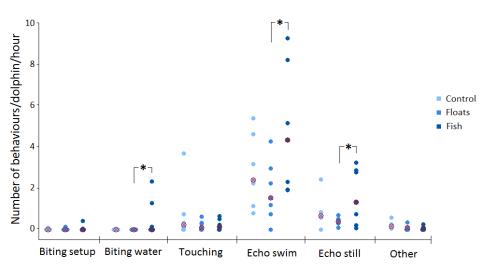Results
Behavioural observations

During the present study behavioural data was also collected using an Ethogram, which can contribute to an understanding of the dolphins’ interest towards the different test scenarios (control, floats and fish).
It was found that there were no significant differences between any of the three scenarios in the behaviours “Biting set-up”, “Touching” and “Other” (fig 1). However, a significant difference in the number of behaviours per dolphin per hour could be seen in some of the behaviours, where the dolphins performed significantly more “Biting water” towards the fish setup than towards the floats, whereas there were no significant differences between the control and the floats nor between the control and the fish in “Biting water”. With the echolocating behaviours (“Echo swim” and “Echo still”) significant differences were also found. The dolphins performed significantly more “Echo swim” behaviours towards the fish than towards the floats, but there were no significant differences between the control and the floats, nor the control and the fish. A similar observation was seen in “Echo still”, where the dolphins performed significantly more “Echo still” behaviours towards the fish than towards the floats. No significant differences could be seen between the control and the floats in the “Echo still” behaviour. There was likewise no significant difference in the amount of “Echo still” behaviours between the control and the fish.
Responsible for this page:
Director of undergraduate studies Biology
Last updated:
06/05/16
